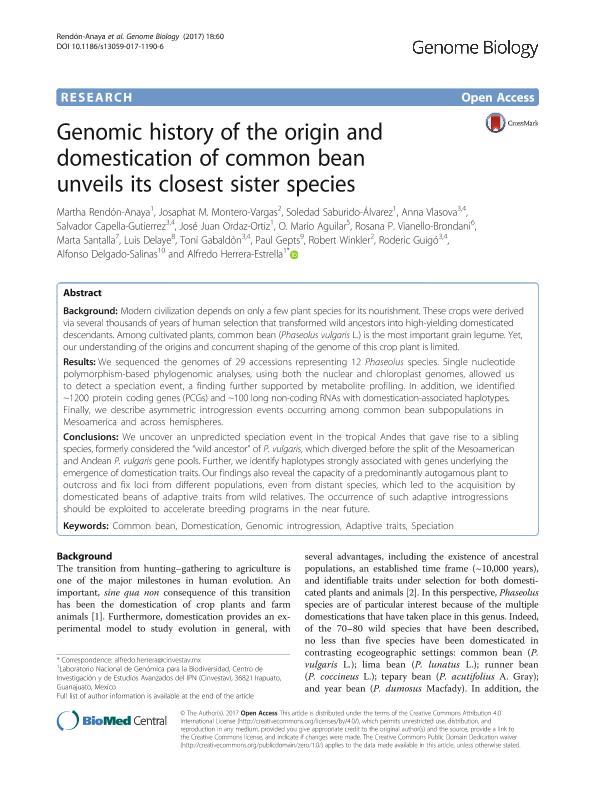Mostrar el registro sencillo del ítem
dc.contributor.author
Rendón Anaya, Martha
dc.contributor.author
Montero Vargas, Josaphat M.
dc.contributor.author
Saburido Álvarez, Soledad
dc.contributor.author
Vlasova, Anna
dc.contributor.author
Capella Gutierrez, Salvador
dc.contributor.author
Ordaz Ortiz, José Juan
dc.contributor.author
Aguilar, Orlando Mario

dc.contributor.author
Vianello Brondani, Rosana P.
dc.contributor.author
Santalla, Marta
dc.contributor.author
Delaye, Luis
dc.contributor.author
Gabaldón, Toni
dc.contributor.author
Gepts, Paul

dc.contributor.author
Winkler, Robert
dc.contributor.author
Guigó, Roderic
dc.contributor.author
Delgado Salinas, Alfonso
dc.contributor.author
Herrera Estrella, Alfredo

dc.date.available
2018-07-30T20:35:04Z
dc.date.issued
2017-03
dc.identifier.citation
Rendón Anaya, Martha; Montero Vargas, Josaphat M.; Saburido Álvarez, Soledad; Vlasova, Anna; Capella Gutierrez, Salvador; et al.; Genomic history of the origin and domestication of common bean unveils its closest sister species; BioMed Central; Genome Biology; 18; 1; 3-2017; 1-17
dc.identifier.issn
1474-7596
dc.identifier.uri
http://hdl.handle.net/11336/53490
dc.description.abstract
Background: Modern civilization depends on only a few plant species for its nourishment. These crops were derived via several thousands of years of human selection that transformed wild ancestors into high-yielding domesticated descendants. Among cultivated plants, common bean (Phaseolus vulgaris L.) is the most important grain legume. Yet, our understanding of the origins and concurrent shaping of the genome of this crop plant is limited. Results: We sequenced the genomes of 29 accessions representing 12 Phaseolus species. Single nucleotide polymorphism-based phylogenomic analyses, using both the nuclear and chloroplast genomes, allowed us to detect a speciation event, a finding further supported by metabolite profiling. In addition, we identified ~1200 protein coding genes (PCGs) and ~100 long non-coding RNAs with domestication-associated haplotypes. Finally, we describe asymmetric introgression events occurring among common bean subpopulations in Mesoamerica and across hemispheres. Conclusions: We uncover an unpredicted speciation event in the tropical Andes that gave rise to a sibling species, formerly considered the "wild ancestor" of P. vulgaris, which diverged before the split of the Mesoamerican and Andean P. vulgaris gene pools. Further, we identify haplotypes strongly associated with genes underlying the emergence of domestication traits. Our findings also reveal the capacity of a predominantly autogamous plant to outcross and fix loci from different populations, even from distant species, which led to the acquisition by domesticated beans of adaptive traits from wild relatives. The occurrence of such adaptive introgressions should be exploited to accelerate breeding programs in the near future.
dc.format
application/pdf
dc.language.iso
eng
dc.publisher
BioMed Central

dc.rights
info:eu-repo/semantics/openAccess
dc.rights.uri
https://creativecommons.org/licenses/by/2.5/ar/
dc.subject
Adaptive Traits
dc.subject
Common Bean
dc.subject
Domestication
dc.subject
Genomic Introgression
dc.subject
Speciation
dc.subject.classification
Otras Ciencias Biológicas

dc.subject.classification
Ciencias Biológicas

dc.subject.classification
CIENCIAS NATURALES Y EXACTAS

dc.title
Genomic history of the origin and domestication of common bean unveils its closest sister species
dc.type
info:eu-repo/semantics/article
dc.type
info:ar-repo/semantics/artículo
dc.type
info:eu-repo/semantics/publishedVersion
dc.date.updated
2018-06-08T14:28:18Z
dc.identifier.eissn
1474-760X
dc.journal.volume
18
dc.journal.number
1
dc.journal.pagination
1-17
dc.journal.pais
Reino Unido

dc.journal.ciudad
Londres
dc.description.fil
Fil: Rendón Anaya, Martha. Instituto Politécnico Nacional. Centro de Investigación y de Estudios Avanzados; México
dc.description.fil
Fil: Montero Vargas, Josaphat M.. Instituto Politécnico Nacional. Centro de Investigación y de Estudios Avanzados; México
dc.description.fil
Fil: Saburido Álvarez, Soledad. Instituto Politécnico Nacional. Centro de Investigación y de Estudios Avanzados; México
dc.description.fil
Fil: Vlasova, Anna. Universitat Pompeu Fabra; España. Centre for Genomic Regulation; España
dc.description.fil
Fil: Capella Gutierrez, Salvador. Universitat Pompeu Fabra; España. Centre for Genomic Regulation; España
dc.description.fil
Fil: Ordaz Ortiz, José Juan. Instituto Politécnico Nacional. Centro de Investigación y de Estudios Avanzados; México
dc.description.fil
Fil: Aguilar, Orlando Mario. Consejo Nacional de Investigaciones Científicas y Técnicas. Centro Científico Tecnológico Conicet - La Plata. Instituto de Biotecnología y Biología Molecular. Universidad Nacional de La Plata. Facultad de Ciencias Exactas. Instituto de Biotecnología y Biología Molecular; Argentina
dc.description.fil
Fil: Vianello Brondani, Rosana P.. Embrapa Rice and Bean; Brasil
dc.description.fil
Fil: Santalla, Marta. Consejo Superior de Investigaciones Científicas; España. Mision Biológica de Galicia; España
dc.description.fil
Fil: Delaye, Luis. Instituto Politécnico Nacional. Centro de Investigación y de Estudios Avanzados; México
dc.description.fil
Fil: Gabaldón, Toni. Universitat Pompeu Fabra; España. Centre for Genomic Regulation; España
dc.description.fil
Fil: Gepts, Paul. University of California at Davis; Estados Unidos
dc.description.fil
Fil: Winkler, Robert. Instituto Politécnico Nacional. Centro de Investigación y de Estudios Avanzados; México
dc.description.fil
Fil: Guigó, Roderic. Universitat Pompeu Fabra; España. Centre for Genomic Regulation; España
dc.description.fil
Fil: Delgado Salinas, Alfonso. Universidad Nacional Autónoma de México. Departamento de Botánica. Instituto de Biología; México
dc.description.fil
Fil: Herrera Estrella, Alfredo. Instituto Politécnico Nacional. Centro de Investigación y de Estudios Avanzados; México
dc.journal.title
Genome Biology

dc.relation.alternativeid
info:eu-repo/semantics/altIdentifier/doi/http://dx.doi.org/10.1186/s13059-017-1190-6
dc.relation.alternativeid
info:eu-repo/semantics/altIdentifier/url/https://genomebiology.biomedcentral.com/articles/10.1186/s13059-017-1190-6
Archivos asociados
